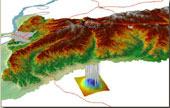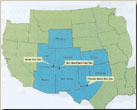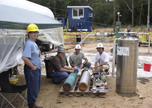News 2007
GCCC scientists Sue Hovorka and JP Nicot attended an EPA-led meeting held in Washington, D. C., December 3-4, 2007: "Proposed UIC Regulations for Geologic Sequestration of Carbon Dioxide." Both Sue and JP also participated in 2 different discussion panels. The meeting lasted 1.5 days with a mix of presentations, technical panels, and question-from-the-audience sessions. EPA is quickly moving forward on the proposed new regulations and was seeking input from a breath of stakeholders.
Bureau Research Scientist Sue Hovorka was recently interviewed by Mason Jones, Videographer, UT Office of Public Affairs, as part of a series of videos that will appear on a new OnCampus website. Sue's discussion of Bureau research on geologic storage to reduce atmospheric emissions of CO2 will be part of a segment on alternative energy.
The Austin Geological Society held its monthly meeting at the Bureau on Monday, November 5. Bureau scientist Tip Meckel spoke on "An Overview of Current Carbon Dioxide Capture and Geologic Storage (Sequestration) Activities in Texas," [PDF] in which he presented basic aspects of carbon capture and storage (CCS) in the context of environmental, energy, and economic factors affecting deployment. He focused on the role of the Bureau in DOE-funded field tests, including the recent DOE award of $38 million for a large-volume test in southwest Mississippi. Close to 50 were in attendance.
JP Nicot participated as an expert in a panel convened by EPA in Washington D.C. on Nov. 2 to review what EPA calls "Vulnerability Evaluation Framework" (VEF). The 4-hour workshop was followed by a 1-hour conference call on Nov. 15. The VEF is an attempt by EPA to streamline the permitting process by making sure that no important issue is overlooked. It could also possibly be used as a decision tool in the future. The VEF approach uses as much as possible simple analytical tools that can be easily applied in a regulatory framework.

Recent GCCC activities at Cranfield include (1) moving to the field under funded Phase 2 of the DOE program ($4.9M) and (2) writing Phase 3 proposal ($38M) which was accelerated by DOE.
A new injection well was drilled, logged, and cored by Denbury at the Cranfield Unit. GCCC researchers Tip Meckel and Bill Ambrose examined the sandstone and conglomerate injection interval and overlying shale seal horizons; partially completed analyses include detailed sedimentological description, compositional XRD, thin section, petrophysical properties, and wireline logs of borehole to match with cored intervals.
Forward plans include work-over of a plugged and abandoned well in the oil-production zone and dedicated novel fiber optic instrumentation for long-term monitoring of temperature and pressure. Multiple packers will isolate a sand horizon above the injection interval to test the concept of 'above zone monitoring' for demonstration of CO2 retention in the injection interval. A field-wide logging campaign is designed to generate data for pressure history matching to assess sweep efficiency in the injection interval and improve assessment of the capacity of the subsurface to store CO2.
A 10-year budget (~$38M for 2008-2018) for GCCC research at Cranfield has been submitted for DOE approval. This will test a formation of regional significance (Tuscaloosa Formation) in the context of industrial-scale injection into brine (1 Mt/yr for 1-1.5 years). Proposed well instrumentation includes active source seismic (cross-well and VSP), electromagnetic, passive downhole micro-seismic, downhole and surface tiltmeters, and InSAR. Goals of the experiment will be to test indirect methods for identifying and quantifying CO2 presence in the deep subsurface, and to monitor geomechanical responses to large-scale injection. Additional monitoring is intended to demonstrate no harm to protected water resources.

Recent GCCC activities for SWCARB Phase 2 include (1) initiation of groundwater sampling and planning of injection experiment at the SACROC (Scurry Area Canyon Reef Operators Committee) unitized oil field; total Phase 2 budget is ($1.2M), and (2) Phase 3 proposal ($5M) preparation.
This past summer GCCC researcher, Becky Smyth, sampled 21 water wells within and to the north and east of SACROC to begin defining the regional variability in groundwater chemistry within various fresh water-bearing units. The water samples have been analyzed for general chemistry, trace metal, and stable isotope water quality parameters at Los Alamos National Laboratories (LANL), one of the SWCARB partners. These wells plus additional ones will be sampled periodically throughout the CO2 injection experiment.
The SACROC pilot injection experiment will consist of several five spot injection patterns. Kinder Morgan will enter wells in these patterns and run reservoir saturation tools (RST) prior to CO2 flooding. SWCARB partners will deploy various
MMV techniques before and during the injection. Kinder Morgan has donated a 3-D seismic volume over the area that will used to help design and interpret MMV data.

The Frio pilot is in the final stages of post-injection monitoring for the second injection at this site. GCCC partners have played key roles in this project from the start in 2003, when BP provided guidance on scope and engineering issues. Schlumberger has processing RST logs from the second experiment, which has proven-up RST as tool of choice for well-based CO2 plume monitoring.
Schlumberger has just conducted sampling with the cased hole formation tester to test this tool as a method to assess well integrity. Praxair has conducted two tests with their surface perfluorocarbon tracer "Seeper trace" and documented that this technology works in geologic storage environments and that the Frio wells are not leak sources.
The second test was conducted with the press observing (ABC News, San Antonio Express-News, and Houston Chronicle) thus achieving the goal of demonstrating to the public that this technology is mature. Final activities at the Frio site will be a VSP survey in 2008, which is a low-budget surface to well seismic survey designed to measure the maximum subsurface spread of the injected CO2.

On July 31, 2007 the FutureGen Texas team submitted their Best and Final Offer (BAFO) to the Alliance. The Odessa and Jewett offers were described in over 1000 pages of documentation (500 pages each). The offers are being evaluated by the Alliance and their team of technical and legal consultants. The evaluation process is being performed in an rigorous fashion to ensure that the final selection meets all federal selection process criteria.
On September 12 the FutureGen Texas team (lead by RRC Chairman Michael Williams and BEG Director Scott Tinker) and the Alliance team (lead by Alliance CEO Mike Mudd) met in Austin for a full day of discussions. The discussions confirmed that the Alliance is leaving no stones unturned. The industry collaboration that has been included in the Texas proposals is getting positive attention from the Alliance. Texas is offering sites that technically, commercially and politically should score extremely well. The team is optimistic that the scheduled site selection in December 2007 will provide good news for the Lone Star State.
On September 13, 2007 GCCC researchers attended the kickoff meeting of the Texas Carbon Capture and Storage Association in Austin, TX. The mission of this organization is to represent the interests of members in the business of carbon capture and storage (CCS) and influence the development of CCS policy in Texas. GCCC research was the only referenced technical subsurface work. There was some discussion of the recently passed Texas state legislation, HB 3732 (Implementation of ultra-clean energy projects) and the high likelihood of FutureGen-like projects being developed soon in Texas.



